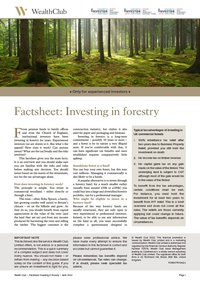Forestry
It’s a relatively simple and very tangible investment. It has delivered impressive performance – better than most other asset classes – over five, 10 and 25 years and is largely uncorrelated to other assets. It offers valuable tax reliefs – no income or capital gains tax, plus inheritance tax relief.
It is little surprise institutional investors – from pension funds to family offices and even the Church of England – have been investing in forestry for years. Experienced private investors are increasingly drawn to it too.
How do forestry investments work?
The principle is simple. You invest in commercial forests for the long term. The trees – predominantly Sitka spruce, a hardy, fast-growing conifer well suited to Britain’s climate – sit on the hillside and grow. As they do so, you should benefit from capital appreciation in the value of the trees (and the land they are on) and from any income produced by harvesting the trees and selling the timber – from the main part of the tree which is used for construction, down to the offcuts, twigs and chippings which are used for biomass.
Investment in forestry is a long-term commitment – possibly 10 years or more – and a forest is by its nature a very illiquid asset. But if you’re comfortable with that, it can have significant tax benefits and once established requires comparatively little upkeep.
Why consider investing in forestry? How does it work? What could it add to your portfolio? What are the benefits and risks?
This roundtable with two respected forestry fund managers will give you the main facts.
Important: The information on this website is for experienced investors. It is not advice nor a research or personal recommendation to invest. If you’re unsure, please seek advice. Investments are for the long term. They are high risk and illiquid and can fall as well as rise in value, so you could get back less than you invest. Whilst Wealth Club and the forestry fund managers are authorised and regulated by the Financial Conduct Authority, the investment in forestry itself is unregulated, so you do not have the usual investor protections, including recourse to the UK Financial Services Compensation Scheme.
Request more information and check if you are eligible to invest – no obligation
Excellent performance track record
UK forestry has a strong long-term performance track record. Based on the most recent data available to us, it was the best-performing UK asset class over a period of five, 10 and 25 years to December 2023, producing annualised returns of 17.9%, 15.8% and 12.4% respectively. Moreover, forestry is broadly uncorrelated to other main asset classes. Please remember, past performance is not a guide to the future.
Discrete annual performance to 31 December of each year
| 2023 | 2022 | 2021 | 2020 | 2019 | |
|---|---|---|---|---|---|
| UK Forestry | 5.4% | 5.4% | 33.3% | 33.3% | 15.6% |
| IA UK Equity Income | 7.1% | -2.6% | 16.6% | -11.4% | 20.6% |
| IA UK All Companies | 7.3% | -9.5% | 15.5% | -6.8% | 23.1% |
| IA £ Corporate Bonds | 9.3% | -16.3% | -1.7% | 7.8% | 9.4% |
| IA Gilts | 3.6% | -24.1% | -4.7% | 8.7% | 6.9% |
| IA UK Direct Property | -0.4% | -7.3% | 7.1% | -4.1% | -0.8% |
Source: Gresham House, Morningstar, to 31 December 2023. Please remember, returns are not guaranteed and past performance is not a guide to the future. Returns for UK forestry have been calculated using the IPD forestry index from December 1995 to its discontinuation in December 2017. There is no suitable replacement index. Gresham House, as the leading forestry asset manager, has supplied return data for 2017 to 2022 based on its managed portfolios, valued once every 24 months. The forestry performance is shown gross of fees. The IA UK Direct Property sector does not have a 25-year track record. The IA sector peer group performance is shown net of underlying fund manager fees.
Typical tax benefits of forestry investments
Investment in UK commercial forestry could have significant tax benefits:
- Inheritance tax: 100% IHT relief after two years due to Business Property Relief, provided you still hold the investment on death
- Income tax: there should be no liability to income tax on timber revenue
- Capital gains tax: there should be no CGT due on any gain made on the value of the timber. The underlying land is subject to CGT although most of the gain would be in the value of the timber
Please remember tax benefits depend on circumstances and tax rules can change.
How could you invest in forestry?
You could buy and manage a forest yourself. This could set you back at least £1 million. A popular alternative is to invest through a forestry fund: for a much smaller outlay you could buy into a large and diversified forestry portfolio, run by a professional manager.
Next steps
Before sending you details on any current forestry deal we are required to check if you are eligible. If you are interested, please request more information by completing the above form and we'll be in touch with next steps.
Wealth Club aims to make it easier for experienced investors to find information on – and apply for – investments. You should base your investment decision on the offer documents and ensure you have read and fully understand them before investing. The information on this webpage is a marketing communication. It is not advice or a personal or research recommendation to buy any of the investments mentioned, nor does it include any opinion as to the present or future value or price of these investments. It does not satisfy legal requirements promoting investment research independence and is thus not subject to prohibitions on dealing ahead of its dissemination.
The details
- Eligibility
- Experienced investors only
- Typical minimum investment
- £50,000+

